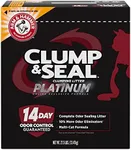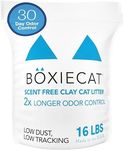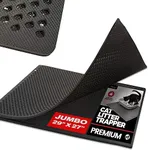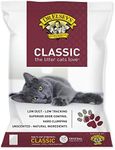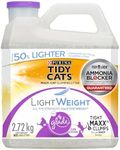Buying Guide for the Best Cat Litter Cats
Choosing the right cat litter is important for both your cat’s comfort and your own convenience. The best cat litter will help control odors, make cleaning easier, and suit your cat’s preferences. Since cats can be particular about their litter, it’s a good idea to understand the different features available so you can select one that works well for your household.Material TypeCat litter comes in several material types, such as clay (clumping or non-clumping), silica gel crystals, recycled paper, wood, corn, and other natural materials. The material affects absorbency, odor control, dust levels, and how easy it is to clean. Clay is popular for its clumping ability, while natural materials are often chosen for being eco-friendly. If your cat has sensitivities or you want a more sustainable option, consider natural or biodegradable litters. If you prioritize easy scooping and strong odor control, clumping clay might be best.
Clumping AbilityClumping litters form solid clumps when wet, making it easier to scoop out waste and keep the box clean. Non-clumping litters absorb moisture but don’t form clumps, so the whole box may need to be changed more often. If you want quick and easy daily cleaning, clumping litter is usually preferred. However, some cats or kittens may do better with non-clumping options, especially if they tend to eat the litter.
Odor ControlOdor control refers to how well the litter masks or neutralizes smells from urine and feces. Some litters use added fragrances or baking soda, while others rely on natural absorption. If your litter box is in a small or shared space, strong odor control can be important. However, some cats dislike scented litters, so if your cat is sensitive, look for unscented options with good natural odor control.
Dust LevelDust level describes how much fine powder is released when you pour or scoop the litter. High-dust litters can cause respiratory issues for both cats and humans, especially in enclosed spaces. Low-dust or dust-free litters are better for sensitive cats or people with allergies. If you notice sneezing or dust settling around the box, consider switching to a low-dust formula.
TrackingTracking is when litter particles stick to your cat’s paws and get carried outside the box. Some litters are designed to minimize tracking with larger or heavier granules. If you’re tired of finding litter around your home, look for low-tracking options. The right choice depends on your cat’s habits and how much stray litter you’re willing to clean up.
AbsorbencyAbsorbency measures how well the litter soaks up moisture. Highly absorbent litters keep the box drier and help control odors. If you have multiple cats or want to change the litter less often, choose a litter with strong absorbency. For single-cat households, moderate absorbency may be sufficient.
Scented vs. UnscentedSome litters are scented to help mask odors, while others are unscented. Scented litters can be helpful in controlling smells, but some cats dislike strong fragrances and may avoid the box. If your cat is sensitive or you prefer a neutral smell, unscented litter is a safer choice. Always observe your cat’s reaction when trying a new scent.
